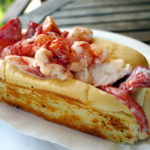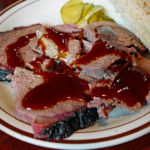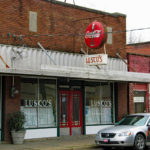Going Coastal
There aren’t many places left like Edisto,” says Charlie White, proprietor of the Edisto Beach Cafe & Grille, which is across the street from the ocean and next to the Piggly Wiggly. We’re standing at his cash register paying for shrimp burgers (piles of grilled shrimp and caramelized onions on a bun) while White explains life on the underdeveloped barrier island. “We’re off the beaten path and we like it that way.” Although Edisto (pronounced “ED-isto”) is not a secret, and a bridge has linked it to the mainland since the ’30s, it remains remarkably tranquil. The nearest city, Charleston, is 45 miles away. It doesn’t have one big-name fast-food franchise (a Burger King opened a while ago but survived just a few years). There are no traffic lights and no motels, and the only thing resembling a theme park is a modest serpentarium.

By Jane and Michael Stern
Originally Published 2003 Gourmet Magazine
There aren’t many places left like Edisto,” says Charlie White, proprietor of the Edisto Beach Cafe & Grille, which is across the street from the ocean and next to the Piggly Wiggly. We’re standing at his cash register paying for shrimp burgers (piles of grilled shrimp and caramelized onions on a bun) while White explains life on the underdeveloped barrier island. “We’re off the beaten path and we like it that way.” Although Edisto (pronounced “ED-isto”) is not a secret, and a bridge has linked it to the mainland since the ’30s, it remains remarkably tranquil. The nearest city, Charleston, is 45 miles away. It doesn’t have one big-name fast-food franchise (a Burger King opened a while ago but survived just a few years). There are no traffic lights and no motels, and the only thing resembling a theme park is a modest serpentarium.
Because its palmetto-shaded beach is the nesting place for endangered loggerhead sea turtles from May through August, disruptive activities are perforce restrained: No toys or picnic gear may be left on the sand at night, and waterfront residents must keep lights off or drapes drawn after dark to make sure the shoreline is serene enough for egg laying. Turtle harassment is punishable by a $20,000 fine.
Farming has been Edisto’s primary inland business for centuries. “We can raise anything in this soil,” boasts Pink Brown of George & Pink vegetable stand. Pink grew up here but went to school on the mainland and remembers waiting hours to return home when the old Dawhoo River swing bridge would get stuck open. The dirt-floored market she runs with her father, George, is down an unpaved road under a canopy of live oaks. Outside, chickens scratch, cluck, and crow, and a huge non-guard dog named Duke squeezes himself into a tire-size flower planter to snooze, oblivious to visitors.
The island’s growing season never ends. In the winter, George & Pink’s bins are filled with potatoes, yams, squashes, cabbages, peppers, cucumbers, and tomatoes that flourish in the island’s fertile soil. The month of May begins what Pink describes as “the peakiest peak of the season, with corn so sweet you want to eat it before you cook it.”
We were clued in to George & Pink by its greatest fan, Philip Bardin, chef and coproprietor (with David Gressette) of The Old Post Office, which occupies Edisto’s best-known piece of real estate other than the beach. In the early 20th century, islanders regularly met here on Saturdays when the mail arrived and on Sundays after church. It continues to be a gathering place for locals, and one night we relished seats within earshot of a table of a dozen stylish members of a women’s social club called the Red Hat Society because they wear bright red hats (and in some cases, bright red dresses to match) whenever they get together.
Everyone who eats at The Old Post Office raves about its grits. Rightfully so, for these are the creamy grits of coastal South Carolina, where cooks slow-simmer them with milk or cream so that they absorb as much dairy richness as coarse-milled corn can hold. “Most chefs do their stocks first thing in the morning,” Bardin told us at 9 A.M. as he whisked two pounds of the ground-to-order grain into a pot of butter-yellow liquid on the stove. “Here, we start the day with grits. I do them early and keep them on the steam table for hours, the longer the better.” The result is a compelling paradox: rugged maize that’s custard-lush. We love them alongside a pillow of brittle-crusted fried flounder or blanketed with a spill of firm broiled shrimp.
We tip our hats to Old Post Office butter beans, which are always served in tandem with those creamy grits. Someone not from the South might glance at them and assume they are nothing more than an obligatory vegetable to round out a meat and starch plate. But these are no ordinary limas; their fleshy opulence will make you reconsider legumes. “It’s like eating steak,” chef Bardin exults, noting that this particular batch is made from Fordhook limas, cooked with country ham.
We visited The Old Post Office in February, the height of oyster season, so we enjoyed the best possible version of its oyster skillet roast. A plate-size cast-iron skillet is loaded with briny Folly Creek oysters (delivered weekly during “R” months by a local oysterman) suspended in a broth of oyster liquor, garlic, and parsley. It’s an enormously addictive dish, offered year round, even when less intoxicating Florida oysters are the only option.
It would be a crime of eating omission to be in South Carolina and not have barbecue. About a third of the way to the beach from the McKinley Washington Jr. Bridge, which now connects the island to the mainland, is a classic pork parlor, Po’ Pigs Bo-B-Q, run by Robert BoBo Lee and his wife, Pam. Adjoining a gas station, it is a rustic buffet with long picnic tables. Here, Edisto families and groups of workmen dine on such pig-pickin’ standards as liver hash on white rice, red rice, turnip greens, limas and ham, hush puppies, and crunchy pork skins. A handwritten sign by the cash register advertises “Big Bag of Skins: $2.50,” but what we like here is the pulled pork—smoky shreds sopped with their own juices and a hint of vinegar.
Tables are outfitted with four squeeze bottles containing different sauces. As we sampled them, debating how each amplified or muffled the subtle flavors of pulled pork, an outspoken old lady sitting alone at the next table turned with some impatience, her finger wagging at the bottles: “You’ve got your mustard sauce, your hot pepper vinegar, your spicy-sweet tomato, and that one there …” She scoffed at an opaque pink sauce that tasted of tomato, mustard, and pepper. “You don’t want that,” she said. “It’s Orangeburg-style.” She shook her head with disdain, then returned to her meal, satisfied that we had received the Word.
The way our informant referred to it, you’d think Orangeburg County, about an hour in from the coast, is as desolate as Siberia. In fact, barbecue buffs consider it the pork hub of the state, home of such legendary establishments as Duke’s, in Orangeburg, and Sweatman’s, in Holly Hill. But a week on the island taught us that to the entrenched Edistonian, most of what’s on the other side of the bridge is immaterial.
Edisto Beach Cafe & Grille (permanently closed)
Highway 174 at Jungle Road
Edisto, SC
The Old Post Office
Po’ Pigs Bo-B-Q (permanently closed)
2410 Highway 174
Edisto, SC
Discuss
What do you think of Going Coastal?
Related Articles
Stroud’s
By Jane and Michael Stern Originally Published 1995 Gourmet Magazine Chicken...
The Lobster Roll Honor Roll
Maine is the only state in America that features a picture of cooked food on its license...
Meat-And-Three
A few years back, country singer Ray Stevens invited a New York friend to join him at one of...
Top 12 favorite Ice Cream Scoops
WITH THE EXCEPTION of the hot dog bun, there has never been an edible invention as...
Top 5 BBQ Restaurants | Western Kentucky
Get yourself to Western Kentucky for great BBQ I see the food shows on TV where...
Best restaurants in Greenwood, MS | Hot Licks Delta Style
Ever since we first ate margarine-sauced pompano at Lusco’s, in Greenwood,...






